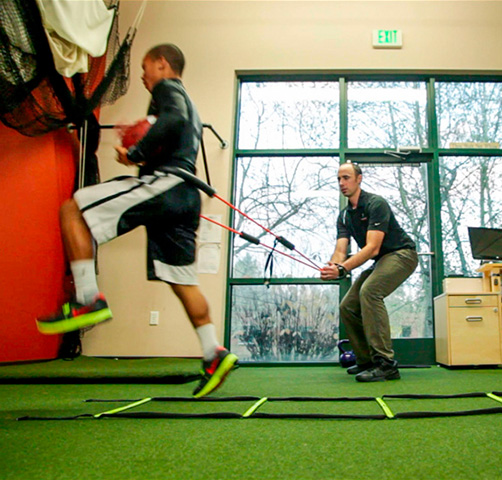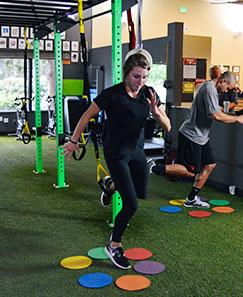Cross country season is a fun one. Running with friends, team camaraderie, pasta feeds before races … these are fond memories for many athletes. Whether you are aiming to set a personal record because of all the training you did over the summer, trying to get in shape for a winter sport, or just looking for a good extracurricular activity, you are in the right place on the cross country team. The last thing you want is to end up with an injury.
While cross country is not generally known as a sport that causes lots of injuries, they do sometimes happen. How to avoid the most common injuries?(1) Read on.
TOP 3 XC INJURIES:
1. Ankle Sprains
- What does this mean?
The ligaments of the ankle get overstretched. Most commonly the ankle rolls inward, spraining the ligaments on the outside of the ankle. Sometimes the upper ankles and shin bones can be involved as well.
- What to do?
If you cannot walk, go to urgent care or the emergency department to make sure the ankle is not broken. Otherwise, manage swelling and pain using the PRICER principles (Protection, Rest, Ice, Compression, Elevation, Referral).
Use an ankle brace or ankle taping to stabilize the ankle when you walk. A school athletic trainer may be able to tape the ankle for you. You may return to running once you can run without increasing your pain.
- Rehabilitation
Please see a physical therapist to rehabilitate from moderate to severe ankle sprains, as they can take longer and be more complicated. Here are ideas to recover from minor sprains:
Restore ankle range of motion using ankle circles and doing an ankle alphabet. Build ankle strength with heel raises and toe pull-aparts using a resistance band. Work on balance by standing on one leg. Challenge yourself to stand on one leg with your eyes closed or when turning your head side to side.
- Prevention
Keep your feet and ankles strong through balance work. Goals:
- 30 single-leg heel raise on each leg
- 30 seconds single-leg balance with eyes closed
2. Patellofemoral Pain Syndrome
- What does this mean?
The knee hurts in the front, under or around the kneecap (also known as the patella). Pain is often brought on with running or stairs, but can also happen at rest or after sitting for too long. Patellofemoral pain is often due to the knee cap rubbing the wrong way on the bone underneath it.
- What to do?
First, rest or cross train. Patellofemoral pain will not go away if you continue to do activities that aggravate it. Sometimes taping or changing footwear can help patellofemoral pain go away more quickly.
Each case is unique. You may need to see a physical therapist or athletic trainer for help with management.
- Rehabilitation
Build hip and core strength using exercises like clamshells, bridges, sidelaying hip abduction, side planks, lateral band walks, and lunges.
Build foot strength and control by spreading your toes, alternating lifting your big toes and little toes, and standing without letting your arches drop.
Build motor control by practicing lunges and squats while maintaining correct alignment: keep your hips, knees, and ankles all in the same line as your body moves up and down.
- Prevention
Make sure you are running with correct alignment: hips, knees and ankles all in the same line. If you feels your knees knocking together or your ankles going wide when you run, see an athletic trainer, physical therapist, or sports medicine physician for help.
Use these exercises to build strength and control. Goals:
-
- 10 single leg bridges with a level pelvis
- 20 lunges on each side
- 30 sec side plank
3. Shin Splints
- What does this mean?
The muscles on the front or inside of the shin are tight and painful when running or walking. This is often an overuse condition from running with an incorrect foot strike.
- What to do?
Rest. Continuing to run on this can make it worse. Ice the painful area. Try massaging the muscles that are sore, and the muscles in the area. Tools like “The Stick” and “The Tiger Tail” can be very helpful for this.
If your symptoms persist after several weeks of trying these things, see a physical therapist, athletic trainer, or sports medicine physician.
- Rehabilitation
Gentle stretching of feet, calves, and hamstrings.
Stretch your foot and calf by putting the ball of your foot against the wall, and then leaning your knee towards the wall. Stretch your hamstring by laying on the floor in a doorway and putting one leg up the wall until you feel a stretch in the back of the thigh.
- Prevention
- Keep lower legs strong and loose. Choose shoes that are comfortable and do not let your feet roll excessively inward or outward. A physical therapist or running shoe store may be able to help you find a pair that works well for you. Goals:
- 30 single leg heel raises on each side
- Loose calf and hamstring muscles
HONORABLE MENTION:
4. Plantar Fasciitis
Pain on the bottom of the heel, especially with the first few steps of the day. This is due to inflammation of the connective tissue on the bottom of the foot.
Try changing footwear or adding arch supports to your shoes.
Work on foot and ankle strength (see “ankle sprain” section above) if possible.
5. IT Band Syndrome
Pain on the outside of the knee or thigh, especially when running or on stairs. This is due to tight connective tissue on the outside of the hip and thigh.
Stretch hips using Figure 4 stretch. Roll on foam roller, focusing on the front of thighs, sides of thighs and hips, and back of thighs and hips.
Work on hip strength (see “patellofemoral pain” section above).
FINAL WORDS:
The BEST thing you can do to prevent youth sports injuries is to play multiple sports.(2) Many youth athletes are specializing early, meaning they just play one sport all year long. This is a setup for burn out, overuse injuries and muscle imbalances due to practicing the same movements over and over. MIX IT UP! KEEP IT FUN! You’ll end up a healthier, stronger, and better athlete overall.

References:
- Wu, AC, Rauh, MJ, DeLuca, S, et al. Running-related injuries in middle school cross-country runners: Prevalence and characteristics of common injuries. PM&R. 2022; 14( 7): 793– 801. https://doi.org/10.1002/pmrj.12649
- Harrast, MA. Clinical Care of the Runner: Assessment Biomechanical Principles, and Injury Management. Elselvier. 2020. ISBN: 978-0-323-67949-7
Experts in Sports Injury Recovery
We are committed to providing effective, efficient, and compassionate care to help you return to pain-free sport. Our passion is to help every patient reach their goals on their journey to recovery and optimal performance.


